Analyzing Semantic Data Application Development Requirements
VerifiedAdded on 2019/12/28
|22
|7036
|384
Report
AI Summary
This report delves into the intricacies of semantic data application development, emphasizing the critical role of requirements analysis. It begins by defining semantic information and its significance in programming design, covering topics like SSL and OpenSSL. The core of the report focuses on the requirements analysis process, including challenges such as miscommunication, difficulties in eliciting information from end-users, and the need to address both current and future system needs. The report then explores various approaches to requirements analysis, including use cases, prototyping, agile development, and interviewing, highlighting the strengths of each method in capturing functional requirements and ensuring that the developed applications meet end-user expectations. The report also mentions the role of business analysts in bridging the gap between end-users and application analysts. The report concludes by summarizing the importance of clear communication, accurate information gathering, and the selection of appropriate methodologies to ensure successful semantic data application development.
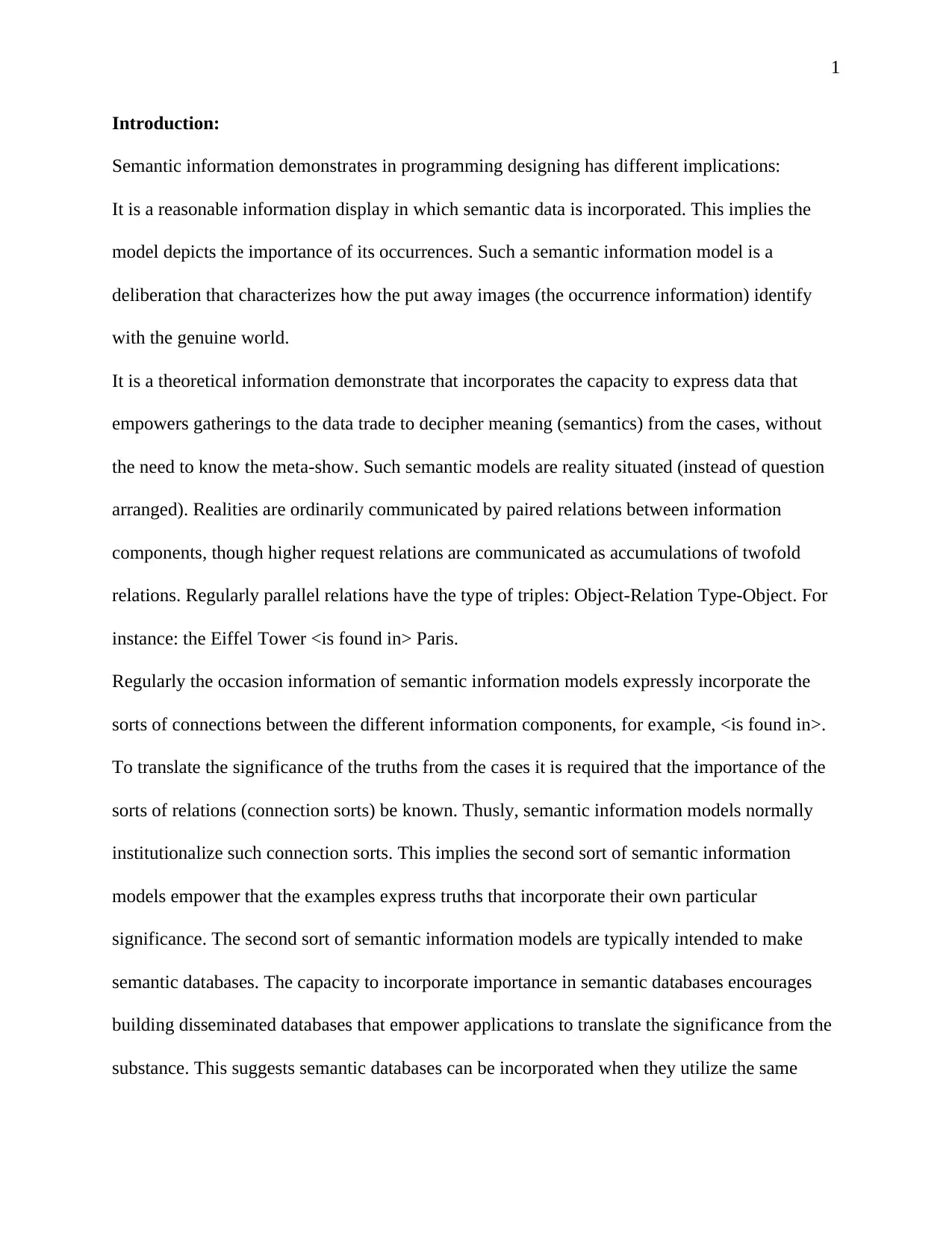
1
Introduction:
Semantic information demonstrates in programming designing has different implications:
It is a reasonable information display in which semantic data is incorporated. This implies the
model depicts the importance of its occurrences. Such a semantic information model is a
deliberation that characterizes how the put away images (the occurrence information) identify
with the genuine world.
It is a theoretical information demonstrate that incorporates the capacity to express data that
empowers gatherings to the data trade to decipher meaning (semantics) from the cases, without
the need to know the meta-show. Such semantic models are reality situated (instead of question
arranged). Realities are ordinarily communicated by paired relations between information
components, though higher request relations are communicated as accumulations of twofold
relations. Regularly parallel relations have the type of triples: Object-Relation Type-Object. For
instance: the Eiffel Tower <is found in> Paris.
Regularly the occasion information of semantic information models expressly incorporate the
sorts of connections between the different information components, for example, <is found in>.
To translate the significance of the truths from the cases it is required that the importance of the
sorts of relations (connection sorts) be known. Thusly, semantic information models normally
institutionalize such connection sorts. This implies the second sort of semantic information
models empower that the examples express truths that incorporate their own particular
significance. The second sort of semantic information models are typically intended to make
semantic databases. The capacity to incorporate importance in semantic databases encourages
building disseminated databases that empower applications to translate the significance from the
substance. This suggests semantic databases can be incorporated when they utilize the same
Introduction:
Semantic information demonstrates in programming designing has different implications:
It is a reasonable information display in which semantic data is incorporated. This implies the
model depicts the importance of its occurrences. Such a semantic information model is a
deliberation that characterizes how the put away images (the occurrence information) identify
with the genuine world.
It is a theoretical information demonstrate that incorporates the capacity to express data that
empowers gatherings to the data trade to decipher meaning (semantics) from the cases, without
the need to know the meta-show. Such semantic models are reality situated (instead of question
arranged). Realities are ordinarily communicated by paired relations between information
components, though higher request relations are communicated as accumulations of twofold
relations. Regularly parallel relations have the type of triples: Object-Relation Type-Object. For
instance: the Eiffel Tower <is found in> Paris.
Regularly the occasion information of semantic information models expressly incorporate the
sorts of connections between the different information components, for example, <is found in>.
To translate the significance of the truths from the cases it is required that the importance of the
sorts of relations (connection sorts) be known. Thusly, semantic information models normally
institutionalize such connection sorts. This implies the second sort of semantic information
models empower that the examples express truths that incorporate their own particular
significance. The second sort of semantic information models are typically intended to make
semantic databases. The capacity to incorporate importance in semantic databases encourages
building disseminated databases that empower applications to translate the significance from the
substance. This suggests semantic databases can be incorporated when they utilize the same
Paraphrase This Document
Need a fresh take? Get an instant paraphrase of this document with our AI Paraphraser
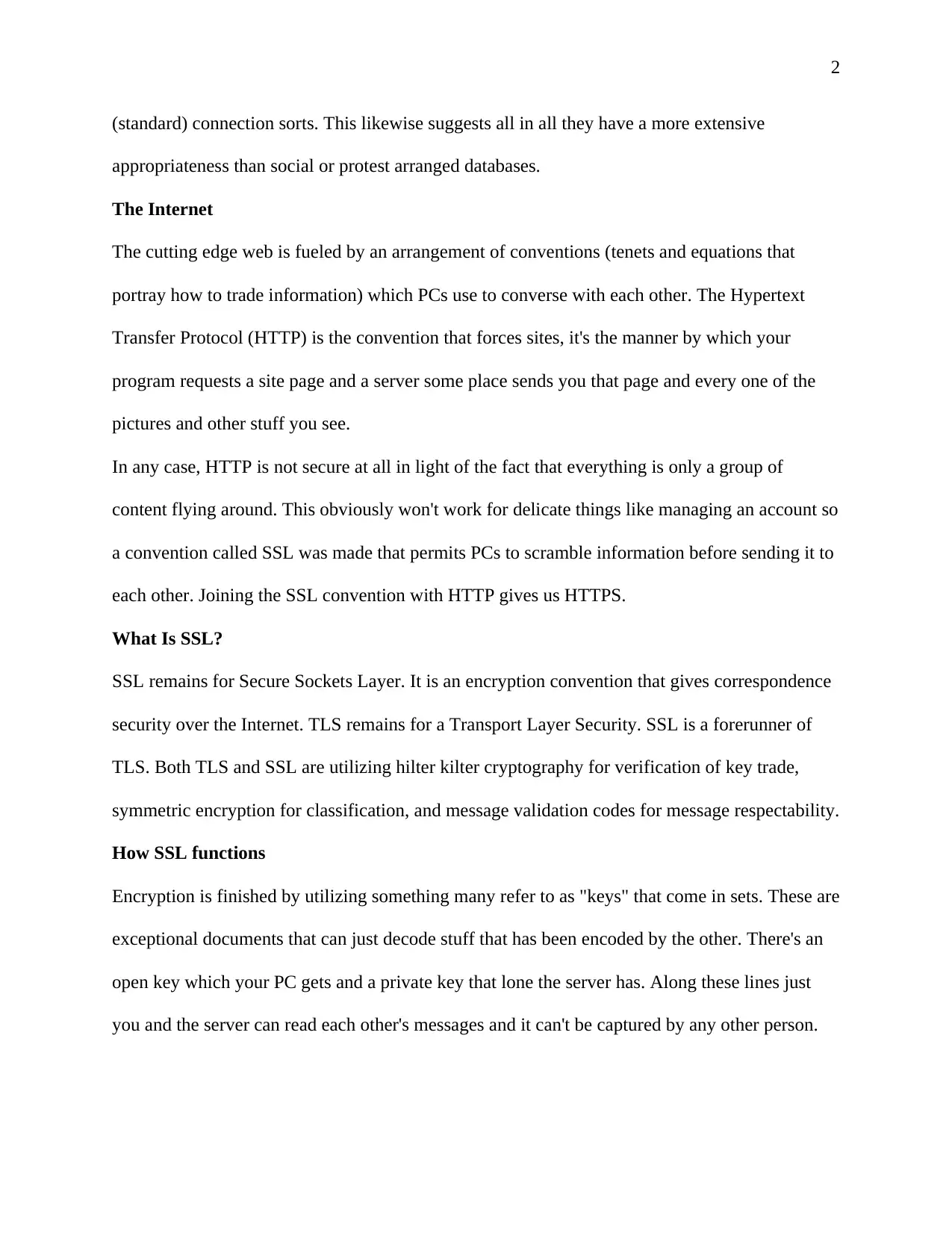
2
(standard) connection sorts. This likewise suggests all in all they have a more extensive
appropriateness than social or protest arranged databases.
The Internet
The cutting edge web is fueled by an arrangement of conventions (tenets and equations that
portray how to trade information) which PCs use to converse with each other. The Hypertext
Transfer Protocol (HTTP) is the convention that forces sites, it's the manner by which your
program requests a site page and a server some place sends you that page and every one of the
pictures and other stuff you see.
In any case, HTTP is not secure at all in light of the fact that everything is only a group of
content flying around. This obviously won't work for delicate things like managing an account so
a convention called SSL was made that permits PCs to scramble information before sending it to
each other. Joining the SSL convention with HTTP gives us HTTPS.
What Is SSL?
SSL remains for Secure Sockets Layer. It is an encryption convention that gives correspondence
security over the Internet. TLS remains for a Transport Layer Security. SSL is a forerunner of
TLS. Both TLS and SSL are utilizing hilter kilter cryptography for verification of key trade,
symmetric encryption for classification, and message validation codes for message respectability.
How SSL functions
Encryption is finished by utilizing something many refer to as "keys" that come in sets. These are
exceptional documents that can just decode stuff that has been encoded by the other. There's an
open key which your PC gets and a private key that lone the server has. Along these lines just
you and the server can read each other's messages and it can't be captured by any other person.
(standard) connection sorts. This likewise suggests all in all they have a more extensive
appropriateness than social or protest arranged databases.
The Internet
The cutting edge web is fueled by an arrangement of conventions (tenets and equations that
portray how to trade information) which PCs use to converse with each other. The Hypertext
Transfer Protocol (HTTP) is the convention that forces sites, it's the manner by which your
program requests a site page and a server some place sends you that page and every one of the
pictures and other stuff you see.
In any case, HTTP is not secure at all in light of the fact that everything is only a group of
content flying around. This obviously won't work for delicate things like managing an account so
a convention called SSL was made that permits PCs to scramble information before sending it to
each other. Joining the SSL convention with HTTP gives us HTTPS.
What Is SSL?
SSL remains for Secure Sockets Layer. It is an encryption convention that gives correspondence
security over the Internet. TLS remains for a Transport Layer Security. SSL is a forerunner of
TLS. Both TLS and SSL are utilizing hilter kilter cryptography for verification of key trade,
symmetric encryption for classification, and message validation codes for message respectability.
How SSL functions
Encryption is finished by utilizing something many refer to as "keys" that come in sets. These are
exceptional documents that can just decode stuff that has been encoded by the other. There's an
open key which your PC gets and a private key that lone the server has. Along these lines just
you and the server can read each other's messages and it can't be captured by any other person.
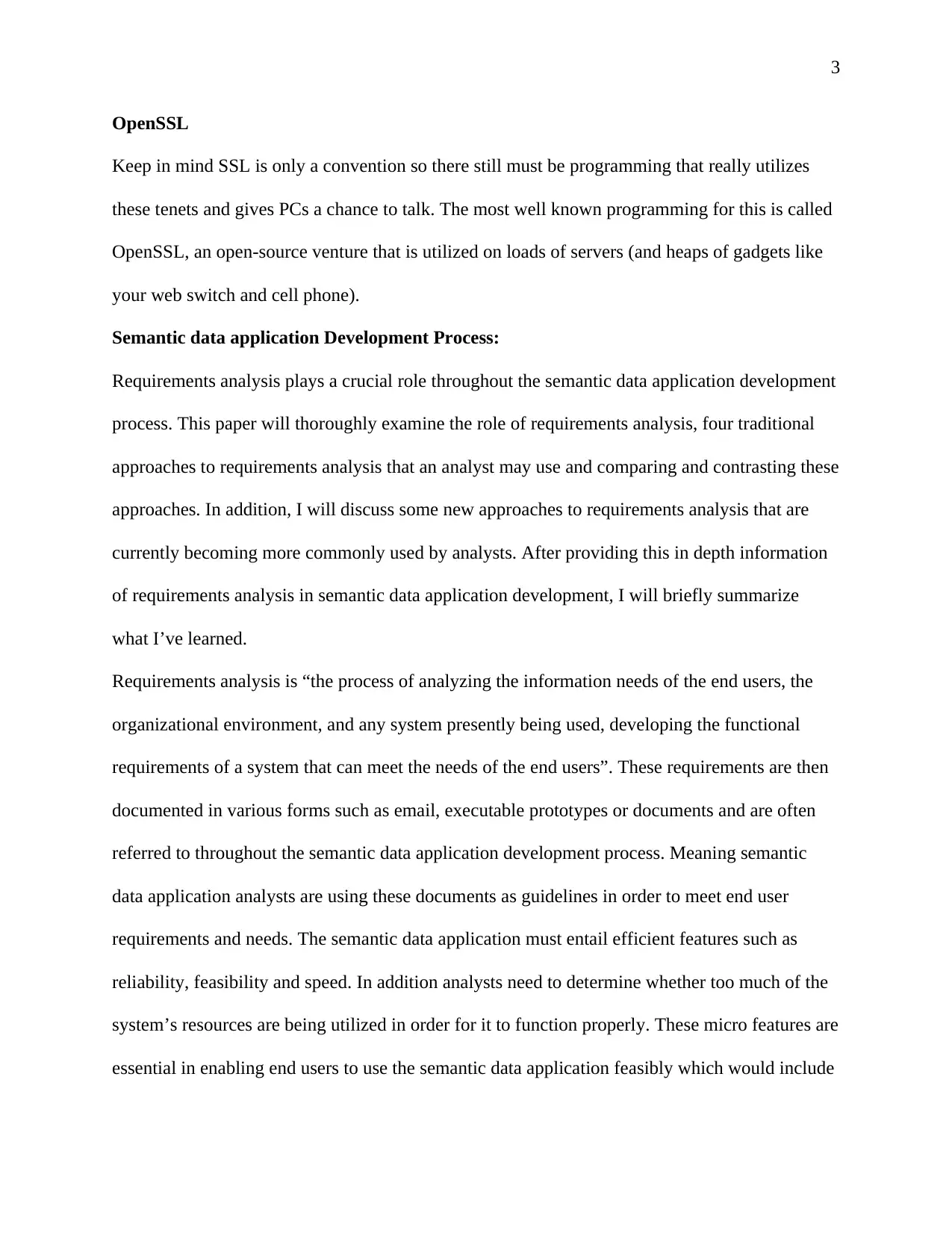
3
OpenSSL
Keep in mind SSL is only a convention so there still must be programming that really utilizes
these tenets and gives PCs a chance to talk. The most well known programming for this is called
OpenSSL, an open-source venture that is utilized on loads of servers (and heaps of gadgets like
your web switch and cell phone).
Semantic data application Development Process:
Requirements analysis plays a crucial role throughout the semantic data application development
process. This paper will thoroughly examine the role of requirements analysis, four traditional
approaches to requirements analysis that an analyst may use and comparing and contrasting these
approaches. In addition, I will discuss some new approaches to requirements analysis that are
currently becoming more commonly used by analysts. After providing this in depth information
of requirements analysis in semantic data application development, I will briefly summarize
what I’ve learned.
Requirements analysis is “the process of analyzing the information needs of the end users, the
organizational environment, and any system presently being used, developing the functional
requirements of a system that can meet the needs of the end users”. These requirements are then
documented in various forms such as email, executable prototypes or documents and are often
referred to throughout the semantic data application development process. Meaning semantic
data application analysts are using these documents as guidelines in order to meet end user
requirements and needs. The semantic data application must entail efficient features such as
reliability, feasibility and speed. In addition analysts need to determine whether too much of the
system’s resources are being utilized in order for it to function properly. These micro features are
essential in enabling end users to use the semantic data application feasibly which would include
OpenSSL
Keep in mind SSL is only a convention so there still must be programming that really utilizes
these tenets and gives PCs a chance to talk. The most well known programming for this is called
OpenSSL, an open-source venture that is utilized on loads of servers (and heaps of gadgets like
your web switch and cell phone).
Semantic data application Development Process:
Requirements analysis plays a crucial role throughout the semantic data application development
process. This paper will thoroughly examine the role of requirements analysis, four traditional
approaches to requirements analysis that an analyst may use and comparing and contrasting these
approaches. In addition, I will discuss some new approaches to requirements analysis that are
currently becoming more commonly used by analysts. After providing this in depth information
of requirements analysis in semantic data application development, I will briefly summarize
what I’ve learned.
Requirements analysis is “the process of analyzing the information needs of the end users, the
organizational environment, and any system presently being used, developing the functional
requirements of a system that can meet the needs of the end users”. These requirements are then
documented in various forms such as email, executable prototypes or documents and are often
referred to throughout the semantic data application development process. Meaning semantic
data application analysts are using these documents as guidelines in order to meet end user
requirements and needs. The semantic data application must entail efficient features such as
reliability, feasibility and speed. In addition analysts need to determine whether too much of the
system’s resources are being utilized in order for it to function properly. These micro features are
essential in enabling end users to use the semantic data application feasibly which would include
⊘ This is a preview!⊘
Do you want full access?
Subscribe today to unlock all pages.

Trusted by 1+ million students worldwide
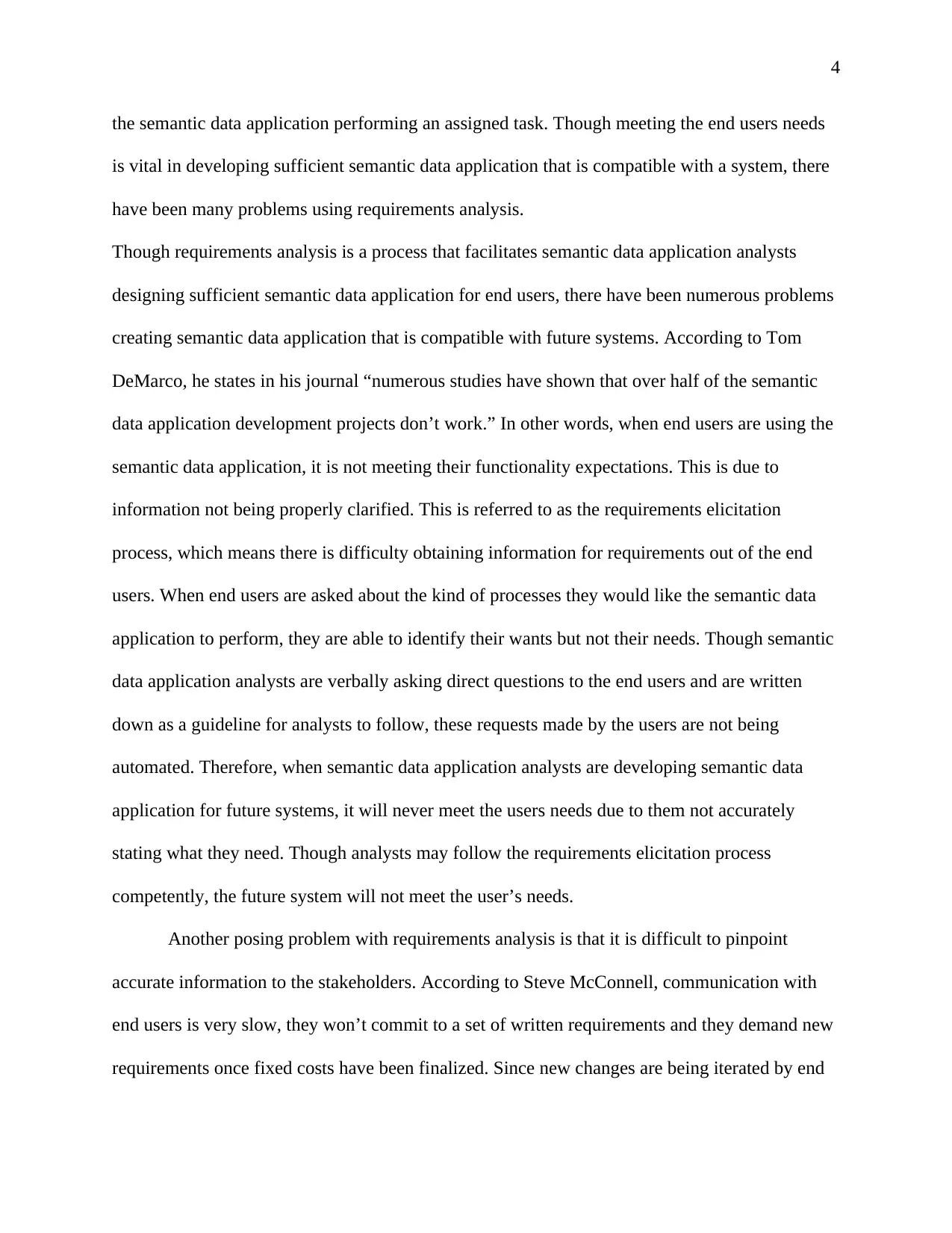
4
the semantic data application performing an assigned task. Though meeting the end users needs
is vital in developing sufficient semantic data application that is compatible with a system, there
have been many problems using requirements analysis.
Though requirements analysis is a process that facilitates semantic data application analysts
designing sufficient semantic data application for end users, there have been numerous problems
creating semantic data application that is compatible with future systems. According to Tom
DeMarco, he states in his journal “numerous studies have shown that over half of the semantic
data application development projects don’t work.” In other words, when end users are using the
semantic data application, it is not meeting their functionality expectations. This is due to
information not being properly clarified. This is referred to as the requirements elicitation
process, which means there is difficulty obtaining information for requirements out of the end
users. When end users are asked about the kind of processes they would like the semantic data
application to perform, they are able to identify their wants but not their needs. Though semantic
data application analysts are verbally asking direct questions to the end users and are written
down as a guideline for analysts to follow, these requests made by the users are not being
automated. Therefore, when semantic data application analysts are developing semantic data
application for future systems, it will never meet the users needs due to them not accurately
stating what they need. Though analysts may follow the requirements elicitation process
competently, the future system will not meet the user’s needs.
Another posing problem with requirements analysis is that it is difficult to pinpoint
accurate information to the stakeholders. According to Steve McConnell, communication with
end users is very slow, they won’t commit to a set of written requirements and they demand new
requirements once fixed costs have been finalized. Since new changes are being iterated by end
the semantic data application performing an assigned task. Though meeting the end users needs
is vital in developing sufficient semantic data application that is compatible with a system, there
have been many problems using requirements analysis.
Though requirements analysis is a process that facilitates semantic data application analysts
designing sufficient semantic data application for end users, there have been numerous problems
creating semantic data application that is compatible with future systems. According to Tom
DeMarco, he states in his journal “numerous studies have shown that over half of the semantic
data application development projects don’t work.” In other words, when end users are using the
semantic data application, it is not meeting their functionality expectations. This is due to
information not being properly clarified. This is referred to as the requirements elicitation
process, which means there is difficulty obtaining information for requirements out of the end
users. When end users are asked about the kind of processes they would like the semantic data
application to perform, they are able to identify their wants but not their needs. Though semantic
data application analysts are verbally asking direct questions to the end users and are written
down as a guideline for analysts to follow, these requests made by the users are not being
automated. Therefore, when semantic data application analysts are developing semantic data
application for future systems, it will never meet the users needs due to them not accurately
stating what they need. Though analysts may follow the requirements elicitation process
competently, the future system will not meet the user’s needs.
Another posing problem with requirements analysis is that it is difficult to pinpoint
accurate information to the stakeholders. According to Steve McConnell, communication with
end users is very slow, they won’t commit to a set of written requirements and they demand new
requirements once fixed costs have been finalized. Since new changes are being iterated by end
Paraphrase This Document
Need a fresh take? Get an instant paraphrase of this document with our AI Paraphraser
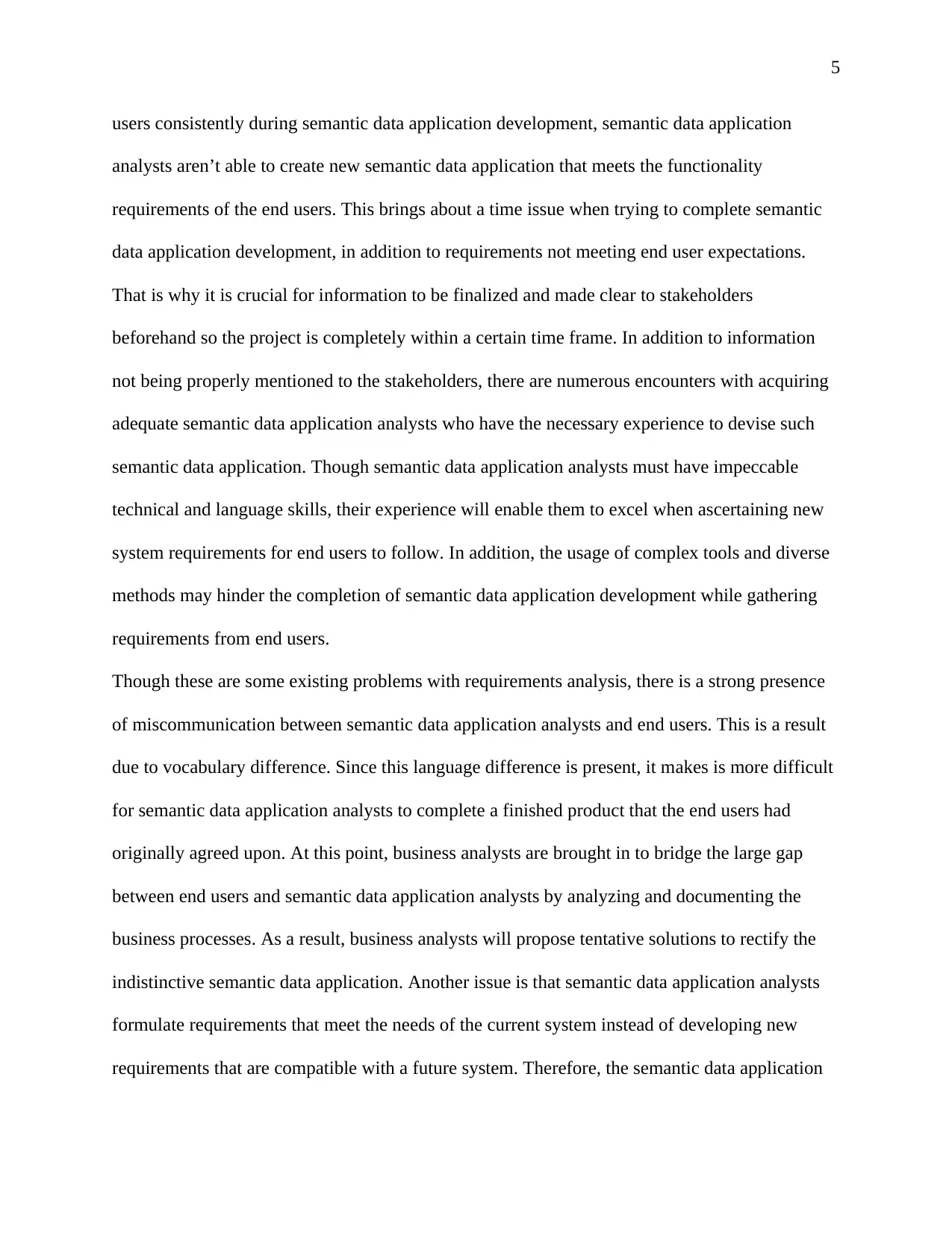
5
users consistently during semantic data application development, semantic data application
analysts aren’t able to create new semantic data application that meets the functionality
requirements of the end users. This brings about a time issue when trying to complete semantic
data application development, in addition to requirements not meeting end user expectations.
That is why it is crucial for information to be finalized and made clear to stakeholders
beforehand so the project is completely within a certain time frame. In addition to information
not being properly mentioned to the stakeholders, there are numerous encounters with acquiring
adequate semantic data application analysts who have the necessary experience to devise such
semantic data application. Though semantic data application analysts must have impeccable
technical and language skills, their experience will enable them to excel when ascertaining new
system requirements for end users to follow. In addition, the usage of complex tools and diverse
methods may hinder the completion of semantic data application development while gathering
requirements from end users.
Though these are some existing problems with requirements analysis, there is a strong presence
of miscommunication between semantic data application analysts and end users. This is a result
due to vocabulary difference. Since this language difference is present, it makes is more difficult
for semantic data application analysts to complete a finished product that the end users had
originally agreed upon. At this point, business analysts are brought in to bridge the large gap
between end users and semantic data application analysts by analyzing and documenting the
business processes. As a result, business analysts will propose tentative solutions to rectify the
indistinctive semantic data application. Another issue is that semantic data application analysts
formulate requirements that meet the needs of the current system instead of developing new
requirements that are compatible with a future system. Therefore, the semantic data application
users consistently during semantic data application development, semantic data application
analysts aren’t able to create new semantic data application that meets the functionality
requirements of the end users. This brings about a time issue when trying to complete semantic
data application development, in addition to requirements not meeting end user expectations.
That is why it is crucial for information to be finalized and made clear to stakeholders
beforehand so the project is completely within a certain time frame. In addition to information
not being properly mentioned to the stakeholders, there are numerous encounters with acquiring
adequate semantic data application analysts who have the necessary experience to devise such
semantic data application. Though semantic data application analysts must have impeccable
technical and language skills, their experience will enable them to excel when ascertaining new
system requirements for end users to follow. In addition, the usage of complex tools and diverse
methods may hinder the completion of semantic data application development while gathering
requirements from end users.
Though these are some existing problems with requirements analysis, there is a strong presence
of miscommunication between semantic data application analysts and end users. This is a result
due to vocabulary difference. Since this language difference is present, it makes is more difficult
for semantic data application analysts to complete a finished product that the end users had
originally agreed upon. At this point, business analysts are brought in to bridge the large gap
between end users and semantic data application analysts by analyzing and documenting the
business processes. As a result, business analysts will propose tentative solutions to rectify the
indistinctive semantic data application. Another issue is that semantic data application analysts
formulate requirements that meet the needs of the current system instead of developing new
requirements that are compatible with a future system. Therefore, the semantic data application
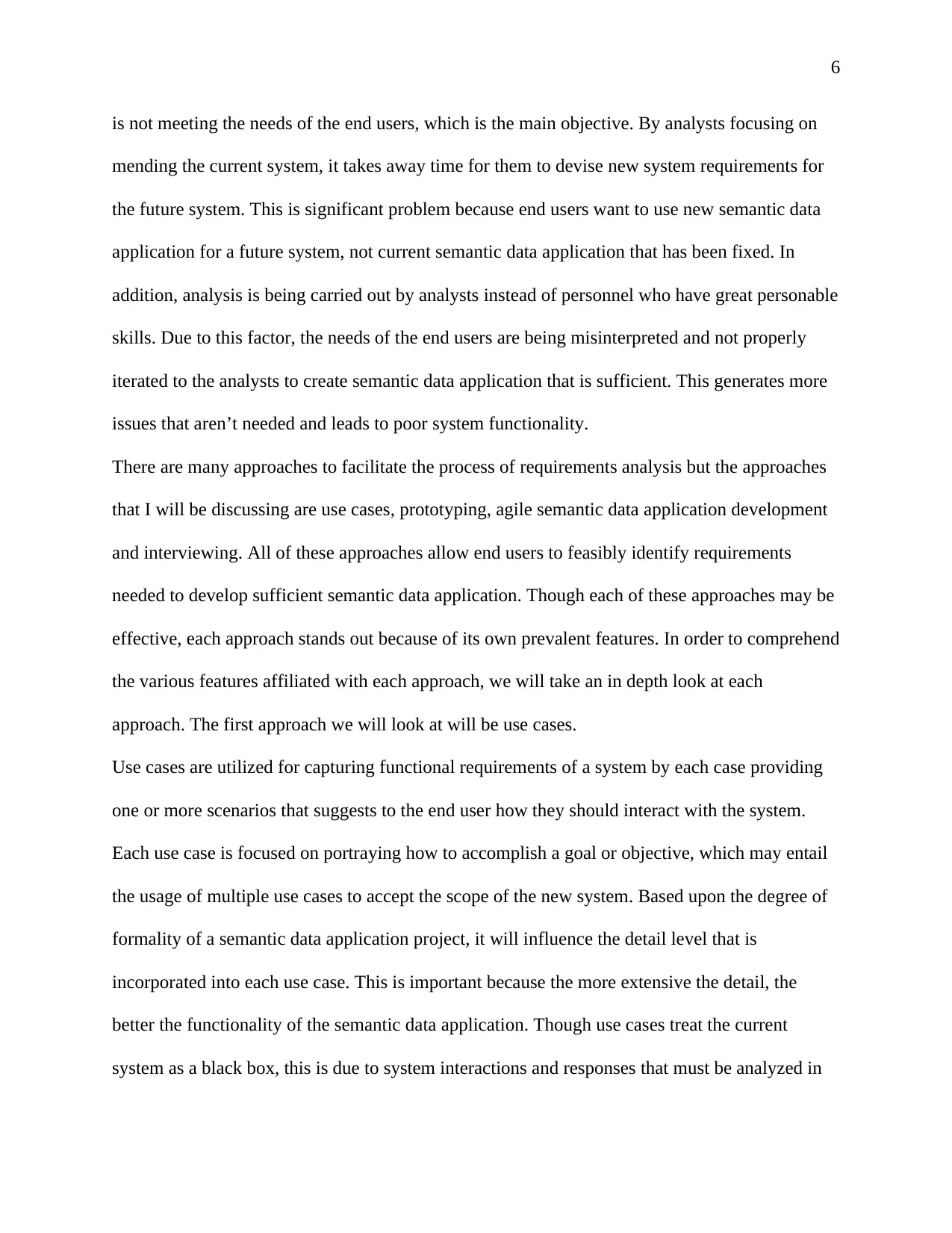
6
is not meeting the needs of the end users, which is the main objective. By analysts focusing on
mending the current system, it takes away time for them to devise new system requirements for
the future system. This is significant problem because end users want to use new semantic data
application for a future system, not current semantic data application that has been fixed. In
addition, analysis is being carried out by analysts instead of personnel who have great personable
skills. Due to this factor, the needs of the end users are being misinterpreted and not properly
iterated to the analysts to create semantic data application that is sufficient. This generates more
issues that aren’t needed and leads to poor system functionality.
There are many approaches to facilitate the process of requirements analysis but the approaches
that I will be discussing are use cases, prototyping, agile semantic data application development
and interviewing. All of these approaches allow end users to feasibly identify requirements
needed to develop sufficient semantic data application. Though each of these approaches may be
effective, each approach stands out because of its own prevalent features. In order to comprehend
the various features affiliated with each approach, we will take an in depth look at each
approach. The first approach we will look at will be use cases.
Use cases are utilized for capturing functional requirements of a system by each case providing
one or more scenarios that suggests to the end user how they should interact with the system.
Each use case is focused on portraying how to accomplish a goal or objective, which may entail
the usage of multiple use cases to accept the scope of the new system. Based upon the degree of
formality of a semantic data application project, it will influence the detail level that is
incorporated into each use case. This is important because the more extensive the detail, the
better the functionality of the semantic data application. Though use cases treat the current
system as a black box, this is due to system interactions and responses that must be analyzed in
is not meeting the needs of the end users, which is the main objective. By analysts focusing on
mending the current system, it takes away time for them to devise new system requirements for
the future system. This is significant problem because end users want to use new semantic data
application for a future system, not current semantic data application that has been fixed. In
addition, analysis is being carried out by analysts instead of personnel who have great personable
skills. Due to this factor, the needs of the end users are being misinterpreted and not properly
iterated to the analysts to create semantic data application that is sufficient. This generates more
issues that aren’t needed and leads to poor system functionality.
There are many approaches to facilitate the process of requirements analysis but the approaches
that I will be discussing are use cases, prototyping, agile semantic data application development
and interviewing. All of these approaches allow end users to feasibly identify requirements
needed to develop sufficient semantic data application. Though each of these approaches may be
effective, each approach stands out because of its own prevalent features. In order to comprehend
the various features affiliated with each approach, we will take an in depth look at each
approach. The first approach we will look at will be use cases.
Use cases are utilized for capturing functional requirements of a system by each case providing
one or more scenarios that suggests to the end user how they should interact with the system.
Each use case is focused on portraying how to accomplish a goal or objective, which may entail
the usage of multiple use cases to accept the scope of the new system. Based upon the degree of
formality of a semantic data application project, it will influence the detail level that is
incorporated into each use case. This is important because the more extensive the detail, the
better the functionality of the semantic data application. Though use cases treat the current
system as a black box, this is due to system interactions and responses that must be analyzed in
⊘ This is a preview!⊘
Do you want full access?
Subscribe today to unlock all pages.

Trusted by 1+ million students worldwide
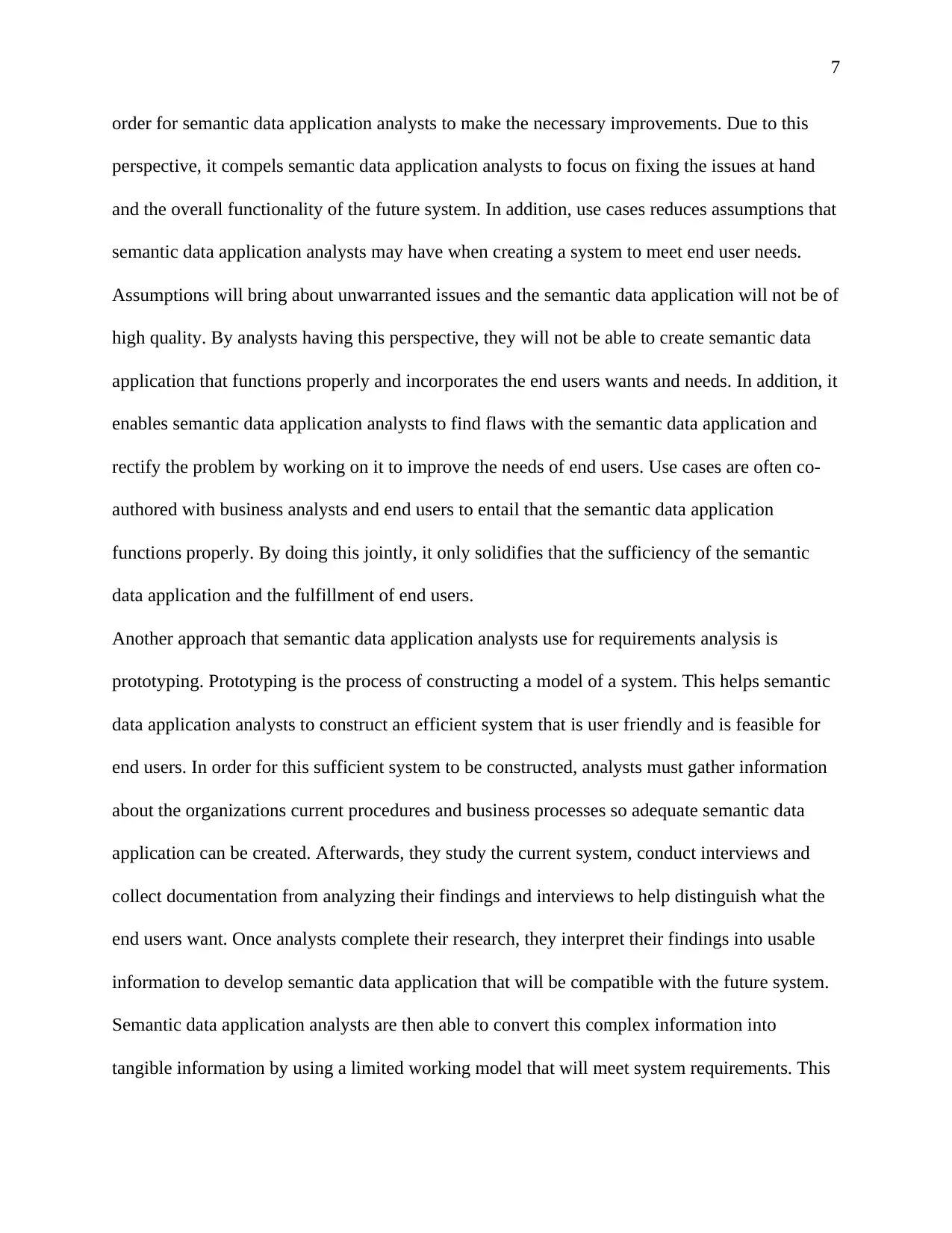
7
order for semantic data application analysts to make the necessary improvements. Due to this
perspective, it compels semantic data application analysts to focus on fixing the issues at hand
and the overall functionality of the future system. In addition, use cases reduces assumptions that
semantic data application analysts may have when creating a system to meet end user needs.
Assumptions will bring about unwarranted issues and the semantic data application will not be of
high quality. By analysts having this perspective, they will not be able to create semantic data
application that functions properly and incorporates the end users wants and needs. In addition, it
enables semantic data application analysts to find flaws with the semantic data application and
rectify the problem by working on it to improve the needs of end users. Use cases are often co-
authored with business analysts and end users to entail that the semantic data application
functions properly. By doing this jointly, it only solidifies that the sufficiency of the semantic
data application and the fulfillment of end users.
Another approach that semantic data application analysts use for requirements analysis is
prototyping. Prototyping is the process of constructing a model of a system. This helps semantic
data application analysts to construct an efficient system that is user friendly and is feasible for
end users. In order for this sufficient system to be constructed, analysts must gather information
about the organizations current procedures and business processes so adequate semantic data
application can be created. Afterwards, they study the current system, conduct interviews and
collect documentation from analyzing their findings and interviews to help distinguish what the
end users want. Once analysts complete their research, they interpret their findings into usable
information to develop semantic data application that will be compatible with the future system.
Semantic data application analysts are then able to convert this complex information into
tangible information by using a limited working model that will meet system requirements. This
order for semantic data application analysts to make the necessary improvements. Due to this
perspective, it compels semantic data application analysts to focus on fixing the issues at hand
and the overall functionality of the future system. In addition, use cases reduces assumptions that
semantic data application analysts may have when creating a system to meet end user needs.
Assumptions will bring about unwarranted issues and the semantic data application will not be of
high quality. By analysts having this perspective, they will not be able to create semantic data
application that functions properly and incorporates the end users wants and needs. In addition, it
enables semantic data application analysts to find flaws with the semantic data application and
rectify the problem by working on it to improve the needs of end users. Use cases are often co-
authored with business analysts and end users to entail that the semantic data application
functions properly. By doing this jointly, it only solidifies that the sufficiency of the semantic
data application and the fulfillment of end users.
Another approach that semantic data application analysts use for requirements analysis is
prototyping. Prototyping is the process of constructing a model of a system. This helps semantic
data application analysts to construct an efficient system that is user friendly and is feasible for
end users. In order for this sufficient system to be constructed, analysts must gather information
about the organizations current procedures and business processes so adequate semantic data
application can be created. Afterwards, they study the current system, conduct interviews and
collect documentation from analyzing their findings and interviews to help distinguish what the
end users want. Once analysts complete their research, they interpret their findings into usable
information to develop semantic data application that will be compatible with the future system.
Semantic data application analysts are then able to convert this complex information into
tangible information by using a limited working model that will meet system requirements. This
Paraphrase This Document
Need a fresh take? Get an instant paraphrase of this document with our AI Paraphraser
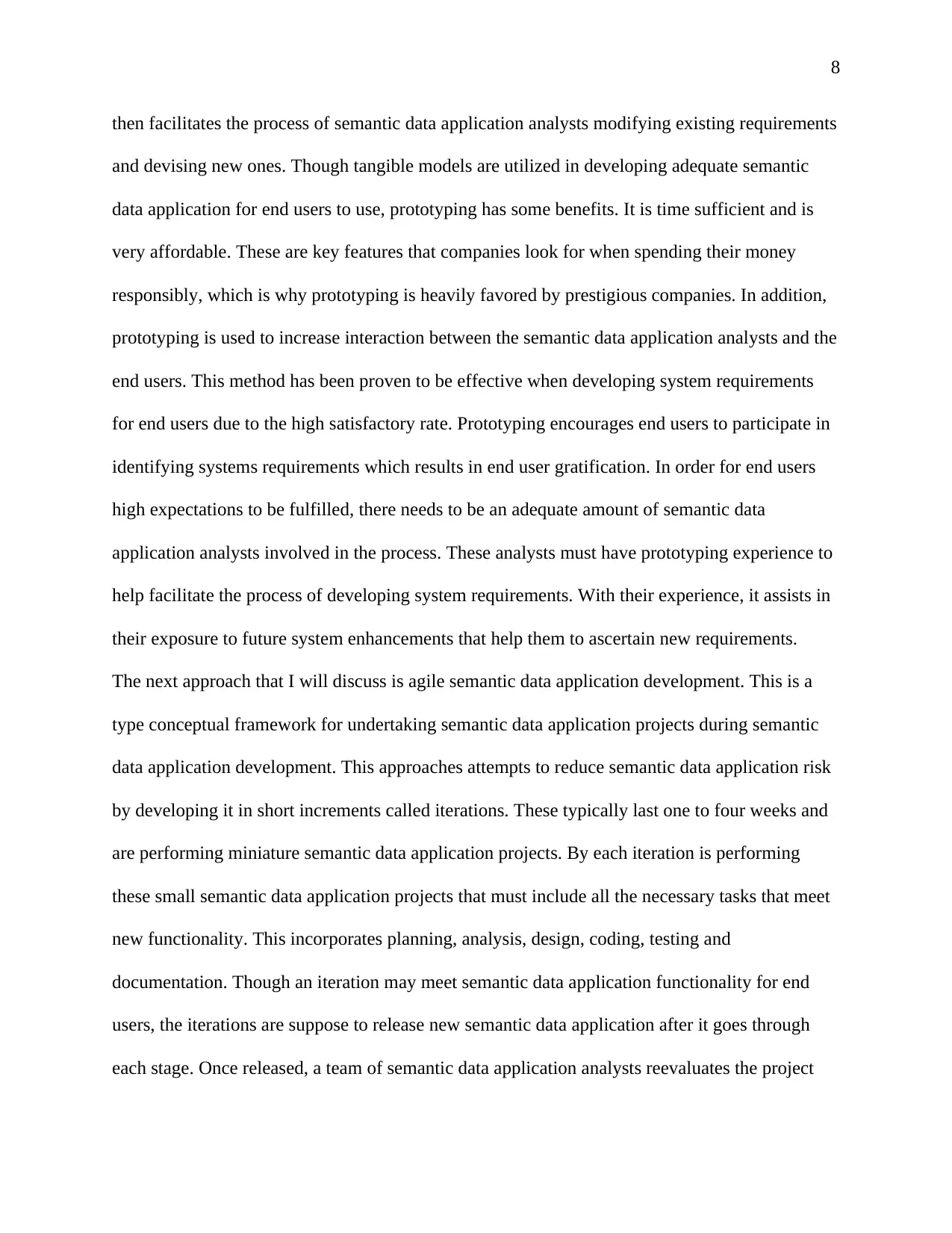
8
then facilitates the process of semantic data application analysts modifying existing requirements
and devising new ones. Though tangible models are utilized in developing adequate semantic
data application for end users to use, prototyping has some benefits. It is time sufficient and is
very affordable. These are key features that companies look for when spending their money
responsibly, which is why prototyping is heavily favored by prestigious companies. In addition,
prototyping is used to increase interaction between the semantic data application analysts and the
end users. This method has been proven to be effective when developing system requirements
for end users due to the high satisfactory rate. Prototyping encourages end users to participate in
identifying systems requirements which results in end user gratification. In order for end users
high expectations to be fulfilled, there needs to be an adequate amount of semantic data
application analysts involved in the process. These analysts must have prototyping experience to
help facilitate the process of developing system requirements. With their experience, it assists in
their exposure to future system enhancements that help them to ascertain new requirements.
The next approach that I will discuss is agile semantic data application development. This is a
type conceptual framework for undertaking semantic data application projects during semantic
data application development. This approaches attempts to reduce semantic data application risk
by developing it in short increments called iterations. These typically last one to four weeks and
are performing miniature semantic data application projects. By each iteration is performing
these small semantic data application projects that must include all the necessary tasks that meet
new functionality. This incorporates planning, analysis, design, coding, testing and
documentation. Though an iteration may meet semantic data application functionality for end
users, the iterations are suppose to release new semantic data application after it goes through
each stage. Once released, a team of semantic data application analysts reevaluates the project
then facilitates the process of semantic data application analysts modifying existing requirements
and devising new ones. Though tangible models are utilized in developing adequate semantic
data application for end users to use, prototyping has some benefits. It is time sufficient and is
very affordable. These are key features that companies look for when spending their money
responsibly, which is why prototyping is heavily favored by prestigious companies. In addition,
prototyping is used to increase interaction between the semantic data application analysts and the
end users. This method has been proven to be effective when developing system requirements
for end users due to the high satisfactory rate. Prototyping encourages end users to participate in
identifying systems requirements which results in end user gratification. In order for end users
high expectations to be fulfilled, there needs to be an adequate amount of semantic data
application analysts involved in the process. These analysts must have prototyping experience to
help facilitate the process of developing system requirements. With their experience, it assists in
their exposure to future system enhancements that help them to ascertain new requirements.
The next approach that I will discuss is agile semantic data application development. This is a
type conceptual framework for undertaking semantic data application projects during semantic
data application development. This approaches attempts to reduce semantic data application risk
by developing it in short increments called iterations. These typically last one to four weeks and
are performing miniature semantic data application projects. By each iteration is performing
these small semantic data application projects that must include all the necessary tasks that meet
new functionality. This incorporates planning, analysis, design, coding, testing and
documentation. Though an iteration may meet semantic data application functionality for end
users, the iterations are suppose to release new semantic data application after it goes through
each stage. Once released, a team of semantic data application analysts reevaluates the project
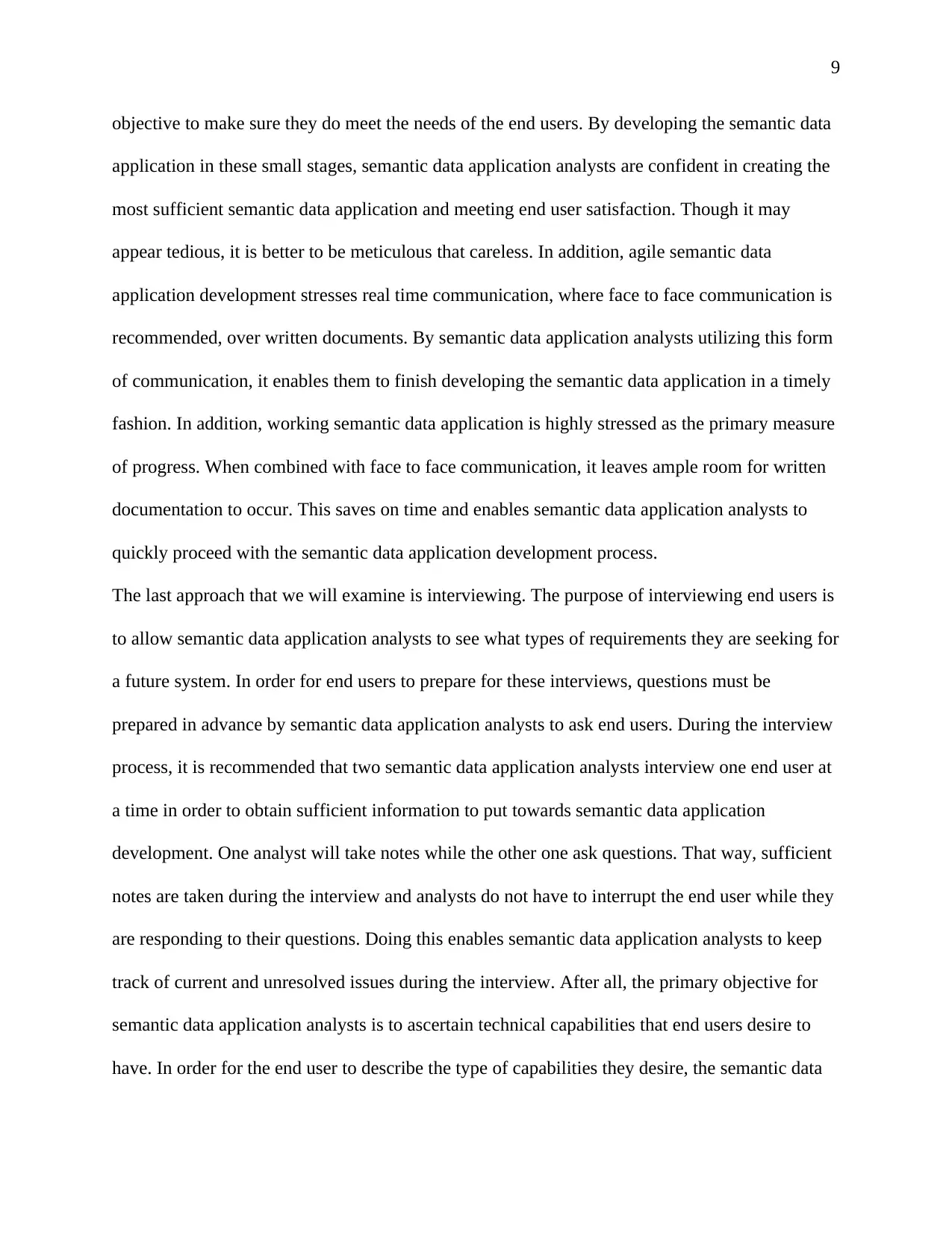
9
objective to make sure they do meet the needs of the end users. By developing the semantic data
application in these small stages, semantic data application analysts are confident in creating the
most sufficient semantic data application and meeting end user satisfaction. Though it may
appear tedious, it is better to be meticulous that careless. In addition, agile semantic data
application development stresses real time communication, where face to face communication is
recommended, over written documents. By semantic data application analysts utilizing this form
of communication, it enables them to finish developing the semantic data application in a timely
fashion. In addition, working semantic data application is highly stressed as the primary measure
of progress. When combined with face to face communication, it leaves ample room for written
documentation to occur. This saves on time and enables semantic data application analysts to
quickly proceed with the semantic data application development process.
The last approach that we will examine is interviewing. The purpose of interviewing end users is
to allow semantic data application analysts to see what types of requirements they are seeking for
a future system. In order for end users to prepare for these interviews, questions must be
prepared in advance by semantic data application analysts to ask end users. During the interview
process, it is recommended that two semantic data application analysts interview one end user at
a time in order to obtain sufficient information to put towards semantic data application
development. One analyst will take notes while the other one ask questions. That way, sufficient
notes are taken during the interview and analysts do not have to interrupt the end user while they
are responding to their questions. Doing this enables semantic data application analysts to keep
track of current and unresolved issues during the interview. After all, the primary objective for
semantic data application analysts is to ascertain technical capabilities that end users desire to
have. In order for the end user to describe the type of capabilities they desire, the semantic data
objective to make sure they do meet the needs of the end users. By developing the semantic data
application in these small stages, semantic data application analysts are confident in creating the
most sufficient semantic data application and meeting end user satisfaction. Though it may
appear tedious, it is better to be meticulous that careless. In addition, agile semantic data
application development stresses real time communication, where face to face communication is
recommended, over written documents. By semantic data application analysts utilizing this form
of communication, it enables them to finish developing the semantic data application in a timely
fashion. In addition, working semantic data application is highly stressed as the primary measure
of progress. When combined with face to face communication, it leaves ample room for written
documentation to occur. This saves on time and enables semantic data application analysts to
quickly proceed with the semantic data application development process.
The last approach that we will examine is interviewing. The purpose of interviewing end users is
to allow semantic data application analysts to see what types of requirements they are seeking for
a future system. In order for end users to prepare for these interviews, questions must be
prepared in advance by semantic data application analysts to ask end users. During the interview
process, it is recommended that two semantic data application analysts interview one end user at
a time in order to obtain sufficient information to put towards semantic data application
development. One analyst will take notes while the other one ask questions. That way, sufficient
notes are taken during the interview and analysts do not have to interrupt the end user while they
are responding to their questions. Doing this enables semantic data application analysts to keep
track of current and unresolved issues during the interview. After all, the primary objective for
semantic data application analysts is to ascertain technical capabilities that end users desire to
have. In order for the end user to describe the type of capabilities they desire, the semantic data
⊘ This is a preview!⊘
Do you want full access?
Subscribe today to unlock all pages.

Trusted by 1+ million students worldwide
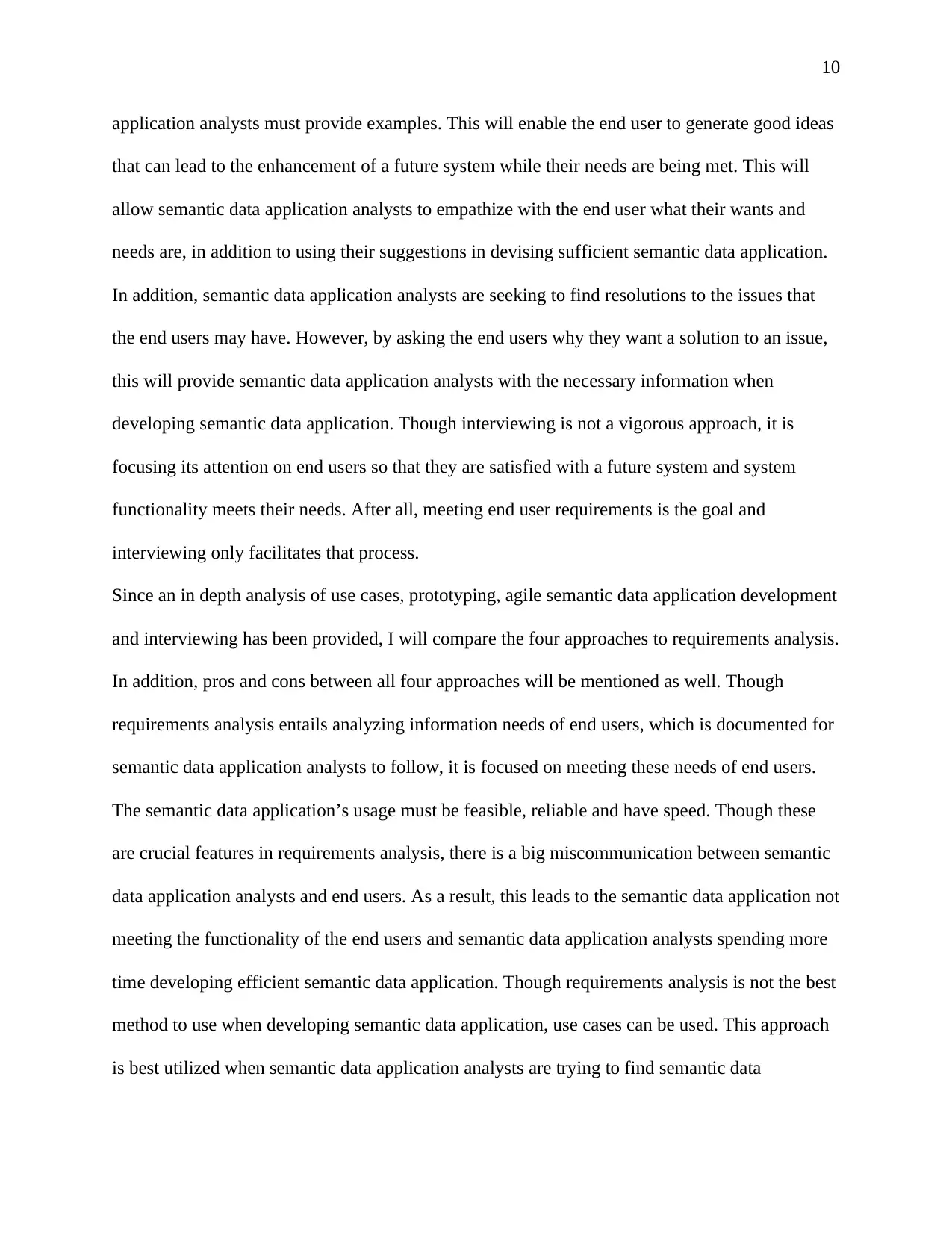
10
application analysts must provide examples. This will enable the end user to generate good ideas
that can lead to the enhancement of a future system while their needs are being met. This will
allow semantic data application analysts to empathize with the end user what their wants and
needs are, in addition to using their suggestions in devising sufficient semantic data application.
In addition, semantic data application analysts are seeking to find resolutions to the issues that
the end users may have. However, by asking the end users why they want a solution to an issue,
this will provide semantic data application analysts with the necessary information when
developing semantic data application. Though interviewing is not a vigorous approach, it is
focusing its attention on end users so that they are satisfied with a future system and system
functionality meets their needs. After all, meeting end user requirements is the goal and
interviewing only facilitates that process.
Since an in depth analysis of use cases, prototyping, agile semantic data application development
and interviewing has been provided, I will compare the four approaches to requirements analysis.
In addition, pros and cons between all four approaches will be mentioned as well. Though
requirements analysis entails analyzing information needs of end users, which is documented for
semantic data application analysts to follow, it is focused on meeting these needs of end users.
The semantic data application’s usage must be feasible, reliable and have speed. Though these
are crucial features in requirements analysis, there is a big miscommunication between semantic
data application analysts and end users. As a result, this leads to the semantic data application not
meeting the functionality of the end users and semantic data application analysts spending more
time developing efficient semantic data application. Though requirements analysis is not the best
method to use when developing semantic data application, use cases can be used. This approach
is best utilized when semantic data application analysts are trying to find semantic data
application analysts must provide examples. This will enable the end user to generate good ideas
that can lead to the enhancement of a future system while their needs are being met. This will
allow semantic data application analysts to empathize with the end user what their wants and
needs are, in addition to using their suggestions in devising sufficient semantic data application.
In addition, semantic data application analysts are seeking to find resolutions to the issues that
the end users may have. However, by asking the end users why they want a solution to an issue,
this will provide semantic data application analysts with the necessary information when
developing semantic data application. Though interviewing is not a vigorous approach, it is
focusing its attention on end users so that they are satisfied with a future system and system
functionality meets their needs. After all, meeting end user requirements is the goal and
interviewing only facilitates that process.
Since an in depth analysis of use cases, prototyping, agile semantic data application development
and interviewing has been provided, I will compare the four approaches to requirements analysis.
In addition, pros and cons between all four approaches will be mentioned as well. Though
requirements analysis entails analyzing information needs of end users, which is documented for
semantic data application analysts to follow, it is focused on meeting these needs of end users.
The semantic data application’s usage must be feasible, reliable and have speed. Though these
are crucial features in requirements analysis, there is a big miscommunication between semantic
data application analysts and end users. As a result, this leads to the semantic data application not
meeting the functionality of the end users and semantic data application analysts spending more
time developing efficient semantic data application. Though requirements analysis is not the best
method to use when developing semantic data application, use cases can be used. This approach
is best utilized when semantic data application analysts are trying to find semantic data
Paraphrase This Document
Need a fresh take? Get an instant paraphrase of this document with our AI Paraphraser
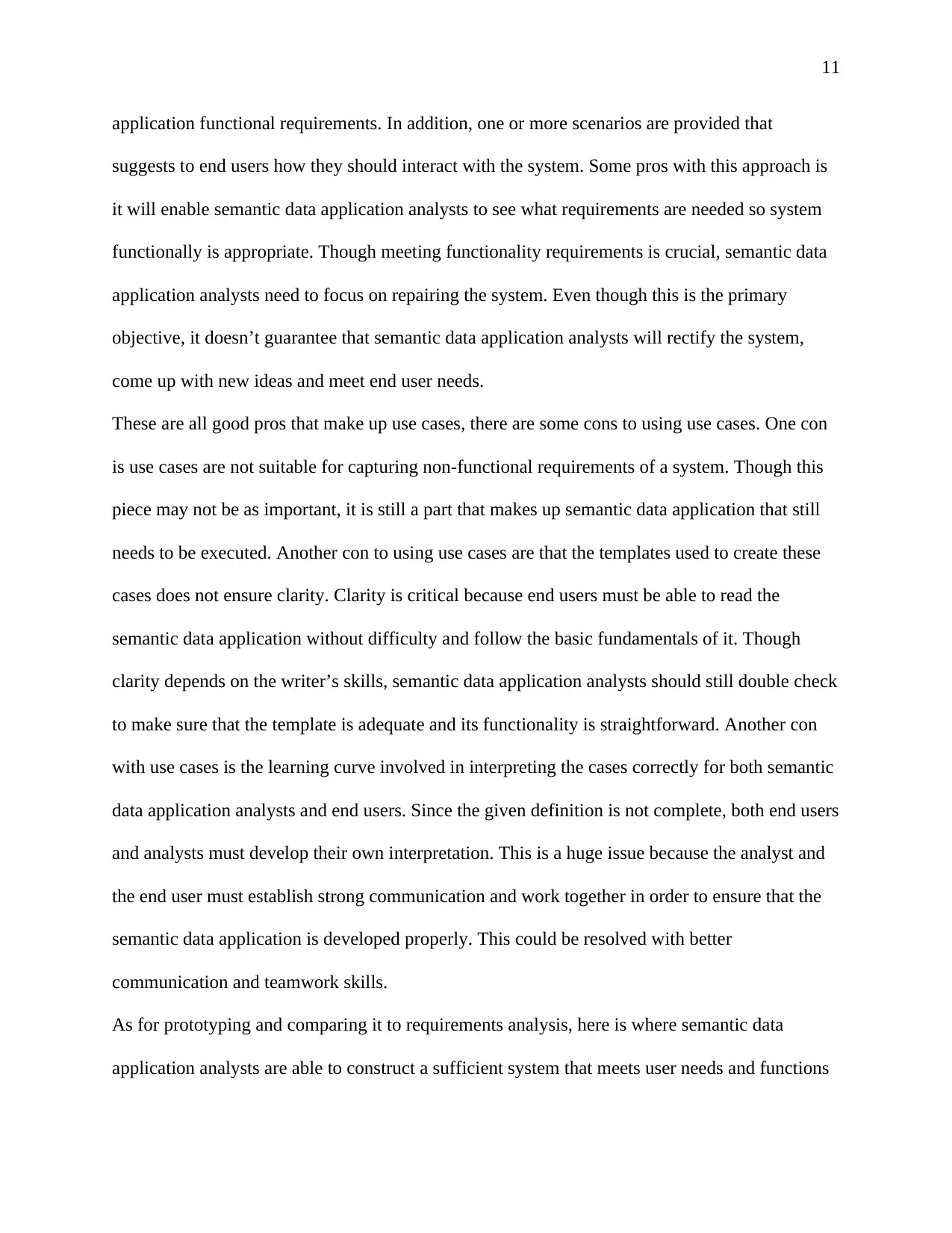
11
application functional requirements. In addition, one or more scenarios are provided that
suggests to end users how they should interact with the system. Some pros with this approach is
it will enable semantic data application analysts to see what requirements are needed so system
functionally is appropriate. Though meeting functionality requirements is crucial, semantic data
application analysts need to focus on repairing the system. Even though this is the primary
objective, it doesn’t guarantee that semantic data application analysts will rectify the system,
come up with new ideas and meet end user needs.
These are all good pros that make up use cases, there are some cons to using use cases. One con
is use cases are not suitable for capturing non-functional requirements of a system. Though this
piece may not be as important, it is still a part that makes up semantic data application that still
needs to be executed. Another con to using use cases are that the templates used to create these
cases does not ensure clarity. Clarity is critical because end users must be able to read the
semantic data application without difficulty and follow the basic fundamentals of it. Though
clarity depends on the writer’s skills, semantic data application analysts should still double check
to make sure that the template is adequate and its functionality is straightforward. Another con
with use cases is the learning curve involved in interpreting the cases correctly for both semantic
data application analysts and end users. Since the given definition is not complete, both end users
and analysts must develop their own interpretation. This is a huge issue because the analyst and
the end user must establish strong communication and work together in order to ensure that the
semantic data application is developed properly. This could be resolved with better
communication and teamwork skills.
As for prototyping and comparing it to requirements analysis, here is where semantic data
application analysts are able to construct a sufficient system that meets user needs and functions
application functional requirements. In addition, one or more scenarios are provided that
suggests to end users how they should interact with the system. Some pros with this approach is
it will enable semantic data application analysts to see what requirements are needed so system
functionally is appropriate. Though meeting functionality requirements is crucial, semantic data
application analysts need to focus on repairing the system. Even though this is the primary
objective, it doesn’t guarantee that semantic data application analysts will rectify the system,
come up with new ideas and meet end user needs.
These are all good pros that make up use cases, there are some cons to using use cases. One con
is use cases are not suitable for capturing non-functional requirements of a system. Though this
piece may not be as important, it is still a part that makes up semantic data application that still
needs to be executed. Another con to using use cases are that the templates used to create these
cases does not ensure clarity. Clarity is critical because end users must be able to read the
semantic data application without difficulty and follow the basic fundamentals of it. Though
clarity depends on the writer’s skills, semantic data application analysts should still double check
to make sure that the template is adequate and its functionality is straightforward. Another con
with use cases is the learning curve involved in interpreting the cases correctly for both semantic
data application analysts and end users. Since the given definition is not complete, both end users
and analysts must develop their own interpretation. This is a huge issue because the analyst and
the end user must establish strong communication and work together in order to ensure that the
semantic data application is developed properly. This could be resolved with better
communication and teamwork skills.
As for prototyping and comparing it to requirements analysis, here is where semantic data
application analysts are able to construct a sufficient system that meets user needs and functions
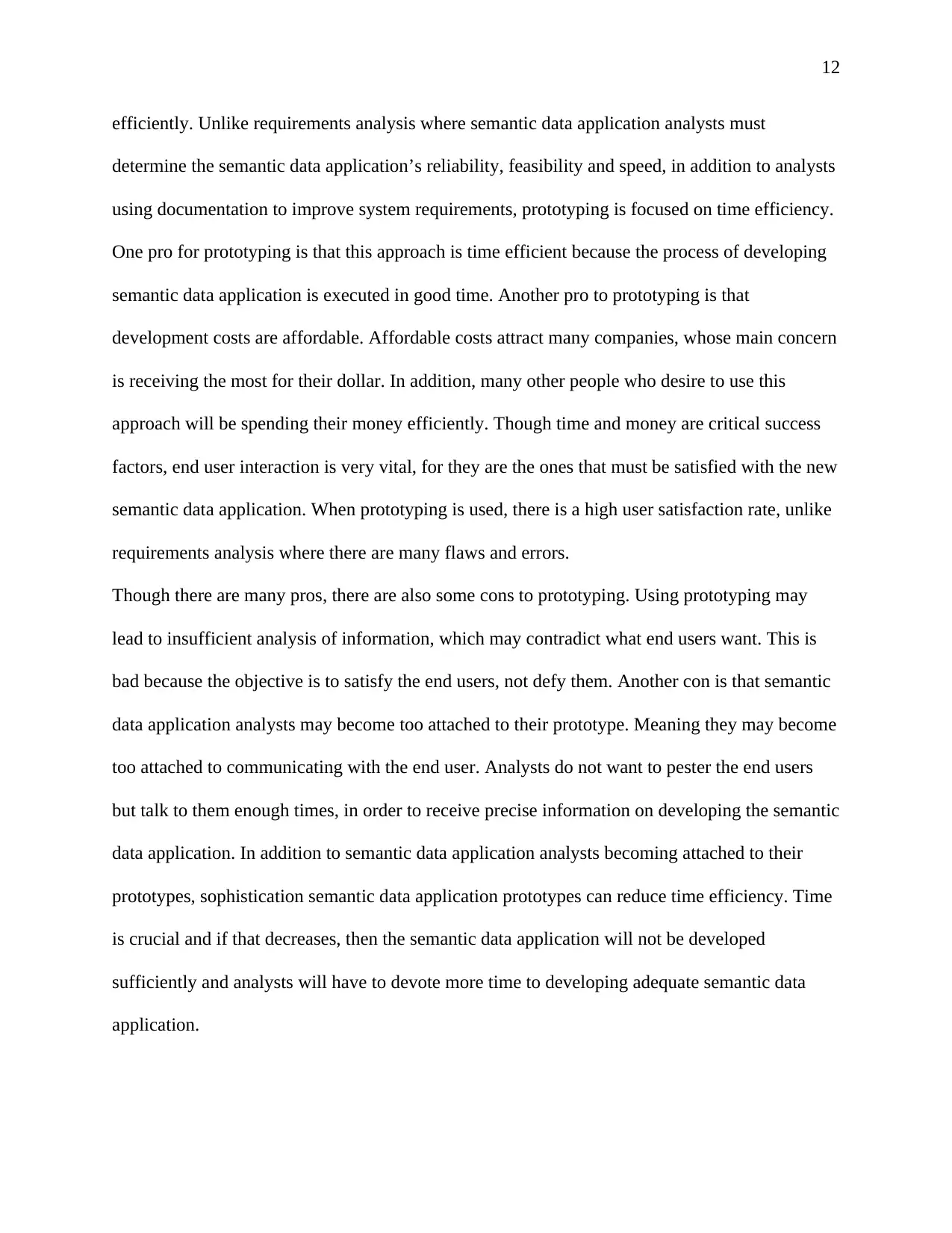
12
efficiently. Unlike requirements analysis where semantic data application analysts must
determine the semantic data application’s reliability, feasibility and speed, in addition to analysts
using documentation to improve system requirements, prototyping is focused on time efficiency.
One pro for prototyping is that this approach is time efficient because the process of developing
semantic data application is executed in good time. Another pro to prototyping is that
development costs are affordable. Affordable costs attract many companies, whose main concern
is receiving the most for their dollar. In addition, many other people who desire to use this
approach will be spending their money efficiently. Though time and money are critical success
factors, end user interaction is very vital, for they are the ones that must be satisfied with the new
semantic data application. When prototyping is used, there is a high user satisfaction rate, unlike
requirements analysis where there are many flaws and errors.
Though there are many pros, there are also some cons to prototyping. Using prototyping may
lead to insufficient analysis of information, which may contradict what end users want. This is
bad because the objective is to satisfy the end users, not defy them. Another con is that semantic
data application analysts may become too attached to their prototype. Meaning they may become
too attached to communicating with the end user. Analysts do not want to pester the end users
but talk to them enough times, in order to receive precise information on developing the semantic
data application. In addition to semantic data application analysts becoming attached to their
prototypes, sophistication semantic data application prototypes can reduce time efficiency. Time
is crucial and if that decreases, then the semantic data application will not be developed
sufficiently and analysts will have to devote more time to developing adequate semantic data
application.
efficiently. Unlike requirements analysis where semantic data application analysts must
determine the semantic data application’s reliability, feasibility and speed, in addition to analysts
using documentation to improve system requirements, prototyping is focused on time efficiency.
One pro for prototyping is that this approach is time efficient because the process of developing
semantic data application is executed in good time. Another pro to prototyping is that
development costs are affordable. Affordable costs attract many companies, whose main concern
is receiving the most for their dollar. In addition, many other people who desire to use this
approach will be spending their money efficiently. Though time and money are critical success
factors, end user interaction is very vital, for they are the ones that must be satisfied with the new
semantic data application. When prototyping is used, there is a high user satisfaction rate, unlike
requirements analysis where there are many flaws and errors.
Though there are many pros, there are also some cons to prototyping. Using prototyping may
lead to insufficient analysis of information, which may contradict what end users want. This is
bad because the objective is to satisfy the end users, not defy them. Another con is that semantic
data application analysts may become too attached to their prototype. Meaning they may become
too attached to communicating with the end user. Analysts do not want to pester the end users
but talk to them enough times, in order to receive precise information on developing the semantic
data application. In addition to semantic data application analysts becoming attached to their
prototypes, sophistication semantic data application prototypes can reduce time efficiency. Time
is crucial and if that decreases, then the semantic data application will not be developed
sufficiently and analysts will have to devote more time to developing adequate semantic data
application.
⊘ This is a preview!⊘
Do you want full access?
Subscribe today to unlock all pages.

Trusted by 1+ million students worldwide
1 out of 22
Your All-in-One AI-Powered Toolkit for Academic Success.
+13062052269
info@desklib.com
Available 24*7 on WhatsApp / Email
![[object Object]](/_next/static/media/star-bottom.7253800d.svg)
Unlock your academic potential
Copyright © 2020–2025 A2Z Services. All Rights Reserved. Developed and managed by ZUCOL.


